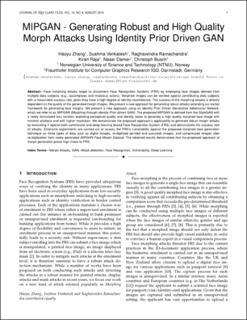MIPGAN—Generating Strong and High Quality Morphing Attacks Using Identity Prior Driven GAN
Zhang, Haoyu; Venkatesh, Sushma; Ramachandra, Raghavendra; Raja, Kiran; Damer, Naser; Busch, Christoph
Journal article, Peer reviewed
Accepted version
Permanent lenke
https://hdl.handle.net/11250/3025455Utgivelsesdato
2021Metadata
Vis full innførselSamlinger
Originalversjon
IEEE Transactions on Biometrics, Behavior, and Identity Science. 2021, 3 (3), 365-383. 10.1109/TBIOM.2021.3072349Sammendrag
Face morphing attacks target to circumvent Face Recognition Systems (FRS) by employing face images derived from multiple data subjects (e.g., accomplices and malicious actors). Morphed images can be verified against contributing data subjects with a reasonable success rate, given they have a high degree of facial resemblance. The success of morphing attacks is directly dependent on the quality of the generated morph images. We present a new approach for generating strong attacks extending our earlier framework for generating face morphs. We present a new approach using an Identity Prior Driven Generative Adversarial Network, which we refer to as MIPGAN (Morphing through Identity Prior driven GAN). The proposed MIPGAN is derived from the StyleGAN with a newly formulated loss function exploiting perceptual quality and identity factor to generate a high quality morphed facial image with minimal artefacts and with high resolution. We demonstrate the proposed approach's applicability to generate strong morphing attacks by evaluating its vulnerability against both commercial and deep learning based Face Recognition System (FRS) and demonstrate the success rate of attacks. Extensive experiments are carried out to assess the FRS's vulnerability against the proposed morphed face generation technique on three types of data such as digital images, re-digitized (printed and scanned) images, and compressed images after re-digitization from newly generated MIPGAN Face Morph Dataset. The obtained results demonstrate that the proposed approach of morph generation poses a high threat to FRS.
